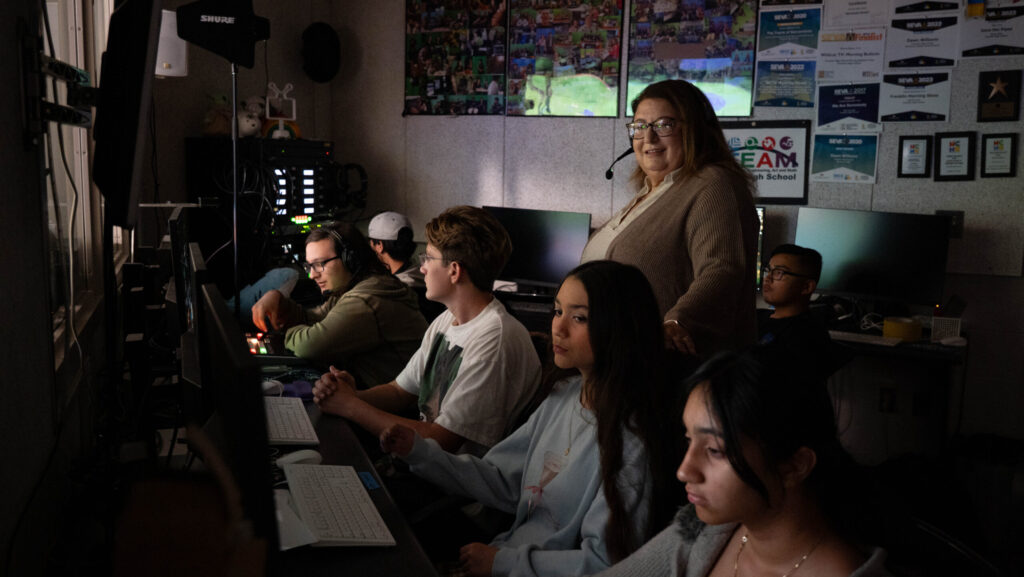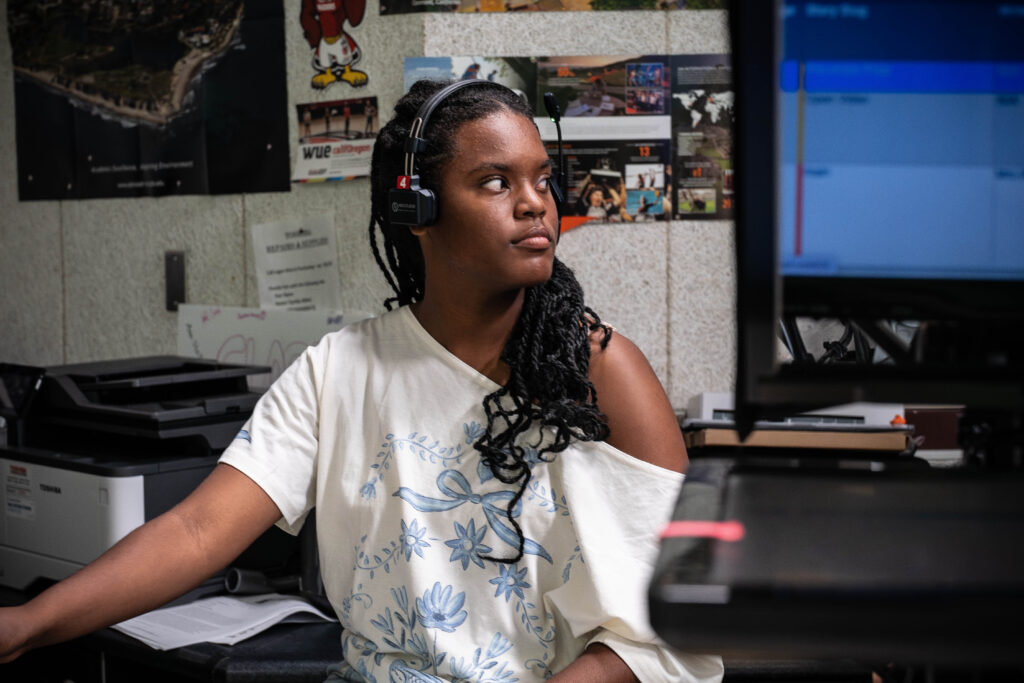The Abridged version:
- The Sacramento Metropolitan Television Cable Commission is considering funding cuts due to declining cable subscriptions.
- A loss in revenue for the Sacramento Educational Cable Consortium would affect media education countywide.
- Parents and teachers say media education is a vital outlet for students across grade levels.
“Five, four, three, two … go,” senior Joshua Henschel gives the cue for his classmates to begin their live broadcast.
Students on the Wildcat TV crew at Franklin High School are gathered, as they are most mornings, before first bell in Dawn Williams’ media classroom.
The space is fashioned as an operating television studio, with a row of cameras pointed at polished anchor desks (donated by ABC10) underneath a ceiling of production lights. A darkened control room punctuated by bright screens peers out behind glass windows. Students buzz around the set, speaking directions into headsets or testing microphones pinned to their collars.
After a few rounds of rehearsals and a quick breakfast, the team is ready to go live to every classroom on campus.
Tuesday’s show is the last of the nine-week quarter for this cohort. But it is far from being the final production at Franklin – they hope.
Supporting organization faces funding cliff
Williams’ class is one of several programs across the region that is facing the possible loss of support from the Sacramento Educational Cable Consortium.
Along with broadcasting 24/7 educational content, the 40-year-old nonprofit works with all 13 school districts in Sacramento County to boost access to media education.
SECC receives most its funding from the Sacramento Metropolitan Television Cable Commission, which for decades raked in fees subscribers pay cable companies. But as streaming services like Netflix and Hulu have increasingly replaced cable subscriptions in homes, the commission’s revenue has withered in recent years.
“Our expenses are going to outpace our revenues within two fiscal years,” said Ryan Brown, chair of the commission. “It’s not declining to zero – but it is declining rapidly enough that it might as well be.”
With a funding cliff on the horizon, the commission has warned its licensee organizations the taps will soon run dry. Along with SECC, Access Sacramento and Sac Life TV receive annual funding. PBS KVIE also receives support for the operation of KVIE2.
The commission planned $544,514 for SECC this year but has proposed dropping it to $340,321 or less.

From equipment to advice
Williams has taught for 28 years, the last 13 in media education. She said much of the equipment that fills her classroom studio was provided by SECC.
The organization also helped teacher Tammy Null with everything from lights to advice throughout her time at multiple schools in Elk Grove Unified School District.
Now in her second year at Joseph Kerr Middle School, Null has helped students turn routine weekly announcements into a more animated news program.
“It’s just been really amazing to be able to do that, and knowing that I have SECC to lean on to be able to build a program like that,” Null said.
Null and her students will have a newly built space for production ready in December, she said. She had hoped SECC would be able to once again help equip and modernize her studio. But with the organization already feeling a budgetary squeeze, Null said she was told they would not be able to assist this time around.
“I’m going to have this amazing room that’s built and I don’t really know what kind of equipment I’m going to be able to honestly afford to put in it,” Null said. “It’s just a bummer.”
Classes have limited sustainability on their own
Were SECC forced to shutter operations, Williams said programs like hers would likely be able to sustain themselves for a handful of years.
But soon, she said, technology becomes outdated. Cameras need replacing and computers need updating, all of which cost more than public schools typically have budgeted.
“As soon as (SECC’s) funding source goes away, we don’t have a pot of money to pull from,” Williams said. “I mean, I can fundraise $500, but $500 is not going to replace a camera.”
Groups search for funding solution
Aaron Heinrich, executive director of SECC since February, said they have been exploring alternative funding sources since the summer in order to stay afloat once the cable commission starts pulling back.
The options, most novel to the organization, include paid school district partnerships, applying for various grants and hosting media workshops for teachers with a cost to attend.
“So, we’ve got these couple of things that we’re just starting,” Heinrich said. “But because we’re just starting them, they aren’t going to immediately backfill any kind of loss in revenue.”
A decision on potential cuts is expected during the cable commission’s next meeting in December, but Brown said he does not yet know what the final outcome and budget will look like.
The commission has been meeting with licensees, including SECC, Brown said.
“We’re exploring different revenue options and generally trying to find some kind of way to thread the needle to allow our licensees to continue providing the key public service that they do,” he said, while also with the understanding that the commission is fundamentally out of money.”

Annual video awards give kids a voice
Matt Sumpter heads the media program at El Camino High School, including the only student-run radio station in Sacramento, KYDS.
Sumpter said his program has received help from SECC in the form of tech support as well as equipment installation in their classroom studio.
But the “single greatest thing” the organization does, he said, is host the annual Student Educational Video Awards. Students across grade levels participate by producing videos and attending an award ceremony in the spring.
“The kids get treated like royalty, and they’re walking the red carpet,” Null said.
For Isla Torres-Harrington, participating in the contest last April gave her an opportunity to not only hone media skills she had learned over the course of the year, but also to immortalize her experience trying to help a classmate of color find a book with a representative main character in the library.
“If the SEVAs hadn’t been a thing, my experience would have been forgotten and nobody would have really cared,” said the now-sixth-grader.
Isla’s father, Sean Harrington, said he was astounded seeing the students’ videos, including his daughter’s.
“It was just really cool to see that these kids had an avenue, a vehicle to express themselves and share what’s going on their lives,” Harrington said. “I don’t know of another medium that really could give these kids that same kind of an opportunity.”
Related from PBS KVIE: The KYDS Are Alright: Student-Run Radio in Sacramento
Savannah Kuchar is a reporter covering education. She came to Sacramento to be a part of the Abridged team and contribute to a crucial local news source.
Correction: An earlier version of this story misstated Ryan Brown’s last name. This story was updated at 8:50 a.m. on Oct. 10, 2025.
